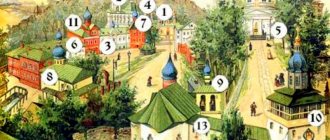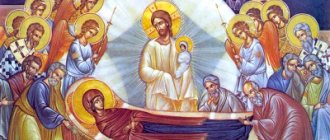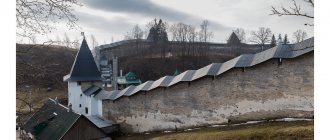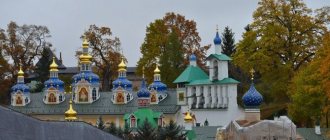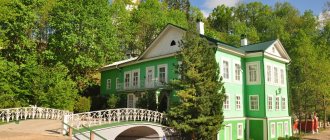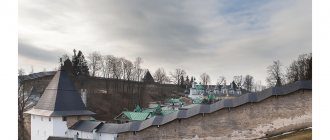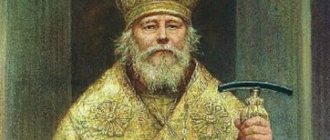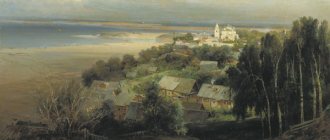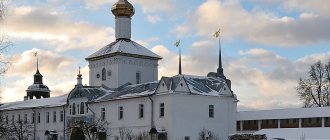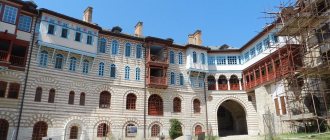In Russia, monasteries have experienced difficult times more than once. They were attacked by enemies, they burned, godless authorities closed them, but there is one monastery in Russia that has never been closed since its founding. This is the Assumption Pskov-Pechersky Monastery, which was founded in 1473. It was founded by the monks of the Kiev Pechersk Lavra, fleeing the raids of the Tatars.
| Holy Dormition Pskov-Pechersky Monastery | |
| A country | Russia |
| City | Pechery |
| Year of foundation | 1473 |
| Website | https://pskovo-pechersky-monastery.ru |
| Abbot | Viceroy Tikhon Shevkunov |
The ancestors of the poets A.S. Pushkin, A.N. Pleshcheev, commander M.I. Kutuzov, composer M.P. Mussorgsky were buried in the monastery; elders, highly respected in the Orthodox world, lived and still live here. Through their prayers great miracles are performed.
Pskov-Pechersky Monastery is one of the largest and most famous monasteries in Russia
The Assumption Pskov-Pechersky Monastery is considered one of the largest and most famous monasteries in Russia. It has a long history and is highly revered in the Orthodox world. The monastery is located 340 km southwest of St. Petersburg and 50 km west of Pskov.
The monastery got its name from the caves located in it, called “God-created” (that is, created by God). It is believed that the monastery was founded in 1473, when the Monk John dug a temple in honor of the Dormition of the Mother of God in a sandy mountain.
The monastery has never been closed in its entire history. During the interwar period (from February 1920 to January 1945) it was located within independent Estonia, thanks to which it was not closed (all monasteries on the territory of the USSR were closed by the end of the 1920s).
1473
this year the Assumption Pskov-Pechersky Monastery was founded
In addition, there is a legend that Archimandrite Alipiy (Voronov), who held the position of rector of the monastery in the 1960s, refused to comply with the decision of the Soviet authorities to close the monastery. He allegedly threatened to raise the front-line soldiers who lived in it to defend her.
Pskov-Pechersky Monastery. Video
Dear visitors to our Orthodox island!
We offer for your viewing a documentary film about the Holy Dormition Pskovo-Pechersk Monastery. This wonderful monastery with a long history is one of the largest in Russia! It never closed! Even in the most brutal atheistic war!
In 1473, the cave Church of the Assumption, dug out of the sand, was consecrated, which is considered the time of the founding of the monastery.
Pskov-Pechersky Monastery
Isn’t every monastery and even individual temple a Gate of Heaven in its essence? This is true. But the essence must be revealed, and expressed, as Father Pavel Florensky emphasized, through the name. The Pskov-Pechersky Assumption Monastery is unofficially called the house of the Blessed Virgin Mary. It is far from accidental that this name emerged from the depths of the people’s consciousness and became attached to the Pechersk monastery.
God-given caves
Located 340 kilometers southwest of St. Petersburg and 50 kilometers west of Pskov, the Assumption Pskov-Pechersky Monastery dates back more than 500 years. Here, on the northwestern borders of Russia, on the ancient land of Pskov, the seeds of the Orthodox faith were grown, sown in Rus' back in the 10th century by the holy Equal-to-the-Apostles Princess Olga. According to legend, she was born in the weight of Vybutskaya near Pskov.
Desert living itself in Rus' began to develop at the end of the 12th and beginning of the 13th centuries, that is, after the founding of the Kiev Pechersk Lavra, which was the highest image of monastic life. Once upon a time, the leader of Russian monks, the Monk Anthony, came to a dense forest on the banks of the Dnieper and settled in a wild cave. He returned from Mount Athos, where the place of his exploits was also a cave. Anthony founded the first monastery in Kievan Rus, which later became one of the most famous. This is the Kiev Pechersk Lavra. Similar to the Kiev-Pechersk monasteries, the Pskov monasteries began to be formed: Eleazarovsky, Krypetsky, Nikandrovsky, as well as the Pskov-Pechersk monastery.
The place where the Pskov caves are located has long been surrounded by a mysterious aura. In ancient times, the Kamenets River was deep, there were beavers in it, and there was a dense forest all around. Izborian trappers nicknamed Selishi hunted in the Pechersk forests. They often heard church singing coming from the mountain, but saw no one. Not knowing the true reason for this phenomenon, trappers attributed the euphonious singing to angels and believed that this place was permeated with God's grace. Perhaps that is why the Izborians acquired this land from the Pskovites. One of the land plots went to the peasant Ivan Dementyev. He settled by the river and built a log house, which was the first building of the village of Pachkovka, named after the river into which the Kamenets stream flowed. Once Dementyev was cutting down a forest on the mountain. A tree standing on a steep cliff fell down and took several more trees along with its roots. The earth in this place crumbled, and a huge hole with the inscription “God-created cave” opened to the peasant’s eyes.
As it turned out, prayer books lived in it, whose singing came from under the mountain. This discovery of the caves took place in 1392, when the lamp of the Russian land was reposed by the Venerable Sergius of Radonezh. The monks see God's providence in this, believing that the northwestern light of Orthodoxy was lit not only from the Kiev Pechersk Lavra, but also through invisible ways from the Trinity-Sergius Lavra. It is unknown how long the hermits labored in the cave, as well as their names. Only one name has been preserved by tradition, the name of St. Mark. The first Pskov monasteries were subjected to terrible devastation by the Livonian knights. Monks were killed and taken captive. It is possible that the Monk Mark was fleeing from them in the forests and caves of the Kamenets River valley. It is also known from local legend that people from the Kiev Pechersk monastery lived in this place, who fled to the Pskov lands due to numerous raids by the Crimean Tatars.
“Sometimes pilgrims ask: “Is it true that you have an underground passage that connects the pechery with Kiev, and the monks came along the underground passage?” We say that there is no underground passage connecting to Kiev. The only connection we have with Kiev is historical, a connection of faith, traditional.”
Be that as it may, it was Mark who laid the foundation for the holy monastery of Pechora and was its forerunner. The legend about St. Mark tells how local hunters saw an old man praying on the hillside. He usually stood above the site of the future Assumption Church, near three stones under the shade of huge oak trees. One stone still lies in the upper monastery garden. And others are believed to have gone into the ground. One of the oak trees, which witnessed those ancient events, has also been preserved.
From the Solovetsky Chronicle it is clear that this hermit is the fourth great desert dweller with a similar name. The first was the Evangelist Mark himself. Spending his life in hermitage and contemplation, Saint Mark of Pskov-Pechersk conquers the flesh, putting it to death in the name of Communion with God. The monk hollowed out an oak log in the shape of a boat, which served as his bed during his earthly life, and at the end of it became a coffin, which was placed in a cave. The holy caves enjoy special veneration today. The entrance to them is located next to the Assumption Cathedral. Above the entrance, the ancient inscription “THE CAVES BUILT BY GOD” has been restored. To the left into a chapel-like room is the tomb of St. Mark. The second tomb is that of St. Jonah, who is already considered the immediate founder of the monastery.
Here's a short history of it. 75 years after the discovery of the caves, priest John Shestnik was sent as a missionary from Moscow to the city of Gert (now Tartu in Estonia). He arrived there with his wife and two sons in 1467. The city of Yuryev, founded by Yaroslav the Wise, was gradually filled with militant Catholics and lost its original name, becoming Gert. John, together with the presbyter Isidore, immediately faced hatred and persecution of the Orthodox, suffering many insults.
“When the oppression by the Livonian knights began, they were forced to leave there in order to save the lives of the children. We learned about the caves created by God, built a temple, and heard about the death of the holy martyr Isidore, who was thrown under the ice on the feast of Epiphany by a Livonian knight. And after the river disappeared in the spring, their bodies, along with their parishioners (more than seventy) were found on the river bank. And in repentance they organized this cathedral.”
But how do they arrange a cathedral? Father John and Mother Maria begin to dig a niche for the temple in the mountain itself, a little to the right of the entrance to the caves created by God. This determined the uniqueness of the Assumption Church for all subsequent centuries. Later, when the Intercession Cathedral was built over the Church of the Assumption, as we see today, five domes on the roof were placed in one row. And usually in a traditional Orthodox church, four domes go around a fifth. The external appearance of the Pechersk Church was determined by the landscape. The building is dug into the holy mountain, and the roof is at the level of its peak, which is, as it were, a continuation of the temple.
<< Video – section
Ipatiev Monastery. Documentary
The founders of the monastery were the monks of another, Kiev-Pechersk, monastery
Reliable information about the beginning of monastic life on the site of the modern Pskov-Pechersk monastery. Scientific research into the origin of the caves located in the monastery was also carried out.
These caves are located in sandstone deposits along the banks of the now existing Kamenets stream. According to some scientists, they may be of natural origin.
Monastic legends say that the caves (pechers) became known to local residents in 1392.
Venerable Mark of Pskov-Pechersky, icon. The Monk Mark is considered the first inhabitant of the Pskov-Pechersk monastery. Photo: pravenc.ru
The monks of the Kiev Pechersk Lavra settled in the caves, fleeing to the Pskov land from the south, from the raids of the Crimean Tatars. From legend, the name of only one of these hermits is known, St. Mark, called the “initial monk” of the monastery.
The chronicle tells how at the end of the 14th century Izborsk hunters, father and son Selisha, heard “the voices of those singing ineffably and beautifully” in a deep forest near the Kamenets stream and felt a fragrance “like a lot of incense.”
1392
this year the caves of the Pskov-Pechersk Lavra became known to local residents
Soon local peasants acquired these lands; by lot they went to Ivan Dementyev, who settled nearby, near the Pachkovka River. One day, when he was cutting down a forest on the side of a mountain, one of the fallen trees, falling, carried the others with it.
Under the roots of one of them, an entrance to a cave opened, and above the entrance there was an inscription: “God-created caves” (Caves created by God). Later, a church was built next to it, consecrated in the name of the Dormition of the Mother of God.
Plan of the caves created by God. The seven galleries-streets of the underground necropolis are numbered, the passage to which comes from nearby caves. At the end of the 6th gallery there is a temple in honor of the Resurrection of Christ. The year of the foundation of the underground Assumption Church is considered the year of the founding of the Pskov-Pechersk monastery. Photo: upload.wikimedia.org
The generally accepted historical date for the founding of the Pskov-Pechersky Monastery is considered to be 1473, when the Assumption Church, dug out of a sandy hill near the Kamenets stream, was consecrated by the Monk Jonah.
He became the immediate founder of the monastery. Later, Ivan Dementyev transferred a plot of land to the monks, and soon a small monastery was formed around the temple. The caves became burial places for monks.
The Pskov-Pechersk monastery flourished in the 16th century
The Pechersk Monastery reached its highest peak in the 16th century. Thus, under Abbot Dorotheos, the Assumption Church on the holy mountain was renewed and expanded. Other buildings were also erected on the territory.
In 1521, the monastery acquired the miraculous icon of the Dormition of the Mother of God “in the hagiography” (with hagiographic stamps).
1521
this year the monastery acquired the icon of the Dormition of the Mother of God
This image was painted by icon painter Alexei Maly at the request of the Pskov “trading people” Vasily and Theodore. During this period, the monastery moved from the mountain down to the Kamenets valley, and the cells were placed opposite the Assumption Church.
Caves of the Pskov-Pechersky Monastery. In the 15th century, monastic life moved from the caves to buildings built at the bottom of the holy mountain. The caves became the burial places of monks. Photo: molitva-info.ru
By the end of the 20s of the 16th century, under Abbot Gerasim, the internal life of the monastery was streamlined: the abbot drew up a communal charter based on the model of the Kiev-Pechersk, established the order of church services according to the tradition of ancient monasteries, decreeing that services should be performed daily in the premises of the Assumption Church.
Nowadays, the monastery today sacredly preserves ancient traditions, observing strict communal regulations. In addition, at this time the monastery also acquired military significance.
Hegumen of the Pskov-Pechersk Lavra Corinilius was killed by Tsar Ivan the Terrible.
The real flourishing of the monastery is associated with its subsequent abbot, the Venerable Martyr Cornelius. In 1541, he erected a refectory church in the monastery in the name of the Annunciation of the Blessed Virgin Mary, expanded the Assumption Church, and dug further monastery caves.
Under him, the monastery turned into a strong fortress. His merit is the construction of powerful stone fortress walls around the monastery (1558 - 1565).
Hegumen Cornelius died in 1570; according to legend, he was personally killed by Tsar Ivan the Terrible, who suspected treason. This happened at the monastery gates. Repentant, the king carried his body in his arms to the Assumption Church.
“Tsar Ivan the Terrible asks Abbot Cornelius to tonsure him as a monk” (K.V. Lebedev). According to legend, the abbot of the Pskov-Pechersk Lavra is St. Corinilius was killed by Tsar Ivan the Terrible due to suspicion of treason. Photo: upload.wikimedia.org
From the beginning of the 17th century until the end of the 19th century, the monastery withstood repeated sieges by Polish and Swedish troops. In addition, it was also besieged by Napoleon's troops.
In memory of the deliverance of Pskov from Napoleonic troops in 1815 - 1827, St. Michael's Cathedral was built, and in 1870 the Sretenskaya Church was built.
1815 — 1827
During this period, St. Michael's Cathedral was built, and in 1870 - Sretenskaya Church
In 1920, according to the Tartu Peace Treaty, the city of Pechory (Petseri) and Pechora County ceded to Estonia, and remained there until Estonia joined the USSR in 1940.
Nowadays, the Assumption Pskov-Pechersky Monastery is actively developing, preserving ancient traditions
During the war, the buildings of the Pskov-Pechersky Monastery were damaged by artillery shelling, the Refectory and the Brotherhood Corps were destroyed. After the occupation, the monastery was under dual subordination: to Metropolitan Alexander (Paulus) of Tallinn and to the Exarch of the Baltic States, Metropolitan Sergius (Voskresensky).
From August 1941 to February 1944, the brethren of the monastery, together with Abbot Pavel (Gorshkov), participated in the Pskov Orthodox mission. The clergy outwardly showed loyalty to the occupation authorities in order to be able to perform divine services
His Holiness Patriarch of Moscow and All Rus' Pimen (Izvekov) June 3, 1971 - May 3, 1990. From 1949 to 1954, Archimandrite Pimen (Izvekov) was the abbot of the Holy Dormition Pskov-Pechersky Monastery. Photo: upload.wikimedia.org
On January 16, 1945, the Pechora region was transferred from the Estonian SSR to the Pskov region of the RSFSR. For about 40 years, only two monasteries operated on the territory of the RSFSR - the Pskov-Pechersk Monastery and the Trinity Lavra of St. Sergius, opened in 1946.
From 1949 to 1954, the governor was Archimandrite Pimen (Izvekov), later the Patriarch of Moscow and All Rus'. In 1957, seven Valaam elders moved to the monastery, having been transported from the island of Valaam to Finland in 1939.
1967 — 2006
During this period, Archimandrite John Krestyankin lived in the Pskov-Pechersk monastery
On July 28, 1959, by decree of Patriarch Alexy, Abbot Alipiy (Voronov) was appointed governor (in 1961 he was elevated to the rank of archimandrite). Father Alypiy did not allow the monastery to be closed during the difficult years of the Khrushchev anti-religious campaign for the church.
Thanks to his efforts, in 1973 the treasures taken by the Nazis from the monastery's sacristy were returned to the monastery. In the 1980s, with the blessing of Metropolitan John (Razumov), extensive restoration work was carried out in the monastery
Archimandrite Alipiy (Voronov). Abbot of the Holy Dormition Pskov-Pechersky Monastery from July 28, 1959 - March 12, 1975. Father Alypiy (Voronov) did not allow the monastery to be closed during Khrushchev’s times. Photo: pravoslavie.ru
The activation of monastic life in the monastery began with the beginning of perestroika in the USSR. In 1986, in the St. Nicholas Tower of the monastery, a temple was consecrated in honor of the Venerable Martyr Cornelius, and in 1995, on the Holy Mountain of the monastery, a wooden church in honor of the Pskov-Pechersk monks was consecrated.
Prominent figures of the Russian Orthodox Church spent the last years of their lives in the monastery, for example, Metropolitan Veniamin (Fedchenkov), Archbishop Vladimir (Kobets), Bishops Theodore (Tekuchev), Ioannikiy (Speransky), Andrey (Sukhenko).
From 1967 to 2006, Archimandrite John (Krestyankin) labored in the monastery. In 2003, Hieroschemamonk Simeon (Zhelnin), who lived in the monastery from 1896 to 1960, was canonized.
Pskov-Pechersky Monastery: according to your faith, may it be for you
Photo by the author The Pskov-Pechersky Monastery is called by many “an open fortress.” The only monastery that has never closed. Miracle! An extraordinary miracle!
Few people know that in Khrushchev’s times, on the instructions of Soviet officials, it was decided to close the monastery. And few people know that the monks were ready to defend their monastery at the cost of their lives. But a miracle happened!
When the Commissioner for Religious Affairs arrived at the monastery with an order to close it, the monastery’s abbot, Archimandrite Alypiy, openly refused to obey the order: he threw the order into the firebox and said: “I’d rather accept martyrdom, but I won’t close the monastery. If you want to use force, know that I have sixty monks, two thirds of whom are participants in the war. They will fight to the last man. And I will dig up Peter’s guns, and we will organize a second defense of Stalingrad. All you have to do is bomb us from an airplane, but you won’t do that, because Europe is nearby—the world community will know.”
Either the words of despair of the archimandrite, or the arrival of Indian Prime Minister Indira Gandhi to the monastery, but the holy monastery still stands. And it will stand!
The Pskov-Pechersky Monastery has always attracted pilgrims. Some went to the shrines, others for the advice of the elder. The chronicle says that Emperor Alexander the First, having heard about the life of one of the monks, the elder Lazar the Farsighted, who on the third day after his death rose from the grave and lived for 16 years, asked to meet with him. The elder met with the emperor and said: “The life of a king should serve as an example for his subjects. Remember, sir, that we have only a short time to live on earth.”
Support the publication
- Join the CLAN
Or
In 1967, one of the elders most revered by Orthodox people, Archimandrite John Krestyankin, became a resident of the monastery. Father died in 2006. Today, Father John's cell is open to pilgrims. There are icons, portraits, photographs on the walls. The cell is very homely and cozy.
Today the abbot of the monastery is Archimandrite Tikhon (Shevkunov).
From the author
When I was getting ready for a trip to the Pskov-Pechersky Monastery, I, of course, “googled” information about the monastery and the governor. Let them forgive me, but I was somewhat shocked when I read what reputable publications wrote about Archimandrite Tikhon (Shevkunov). Like, he studied at VGIK and “suddenly” believed in God! “Spiritual confessor” of Putin himself! “Pissing on” the Lord. And so on and so forth...
I am an ordinary person who does not know the “inner secrets” of the modern church! But I am a journalist and an Orthodox Christian. I don’t care at all what is happening in Orthodoxy today.
But how do you know? Honestly, I threw myself on my knees in front of the priest Father Nikolai, who accompanied me on the trip, and, washing myself with snot and tears, howling: “Enlighten the sinful fool!”, I begged for comments.
Father Nikolai: “What heresy are you reading! Who is Putin’s “spiritual father”? Putin has a confessor on Valaam. The fact that the archimandrite can become the successor of the Bishop is quite likely. And I think that's right. As soon as he became the abbot of the Pskov-Pechersky Monastery, the very first thing he did was return the elderly priests from distant churches to the monastery, and sent the young ones to serve in the distance. A true and wise decision. I can't speak for everyone, but I'll give my honest opinion. Look what is happening now in Orthodoxy! What is happening in Russia now? Russia is an Orthodox country, but there are so many sects around! And they officially exist! What's the matter? Why do these organizations corrupt people's souls? Why is the Lord silent? Having such power.... Agree, but it would be possible to insist on the closure of such organizations. Or is it about money? I think that if Father Tikhon had been, God forgive me, Patriarch, then these sects would not have existed. They would "go back" to where they came from. In America! I can understand everything, sympathize, but I don’t understand some things: why did Vladyka meet with the Pope? For what? It’s a fact that this is not just like that! I won’t go into details, but this, in my opinion, is not entirely true. Why? Two different faiths! Light and shadow. It is the Catholics who are talking about unification. Why does Orthodoxy need it? How many Orthodox Christians were destroyed by Catholics? This should not be mixed. I am sure that under Father Tikhon this could not have happened. And the fact that it is called secular and even “political”, what’s wrong with that? Archimandrite Tikhon is a very educated, energetic person who understands many aspects of life. What's wrong with him meeting with the top officials of the state? From time immemorial this has been the case in Rus'. Yes, he is a very authoritative person in Orthodoxy. Is it true. But he is also very easy to communicate with. You can go to him for a conversation, listen to his sermons, and receive a blessing. And the fact that someone speaks evil….This is from the evil one!”
It is clear that the opinion was expressed by the clergyman. I became interested in what even “not ordinary” but sincerely believing people think.
MEP and Orthodox parishioner Andrei Mamykin : “I read the book of Father Tikhon. It's called "Unholy Saints". It's a masterpiece! Read it with my wife. We had great fun. I can say that Father Tikhon is a cool, modern priest. Perhaps this is what we need in our time. I've heard some media talking about him. Sad! The reason is that their attacks come against Putin through the church. This is undignified. I, as a journalist, would not do that. And the fact that Father Tikhon is meeting with Putin means that our Bishop Alexander is meeting with President Vejonis. And what? This is normal practice. The state and the church have always overlapped. Why now think about who will come after the Patriarch? It’s not for us to talk about this! We were not the ones who gave time to the Master! God bless you. You know, I myself came to God when I needed it. Myself. And now I can say: “Believe. According to your faith, let it be done to you.”
Indeed, faith has always saved and guided Russian people. And what do we care about gossip and speculation when there are such holy places in Rus'!
To be continued…
Add AN to your sources so as not to miss important events - Yandex News
- Sejm Deputy Janina Kursite-Pakule: If 1940 happened again, there would be too many kissing tanks
- Hundreds of Hasidim have gathered on the border between Ukraine and Belarus
- Russian military analyst Knutov: “We have actually driven NATO into a trap in Kaliningrad”
- Economist Krichevsky: all these groups of Kudrin are talking about nothing
- Tragedy on Mount Meron
- The mayor of Yalta asks Aksyonov to allow restaurants and clubs to operate after 11 p.m.
- Retired Colonel of the KGB of the LSSR: The Church is part of the state-political machine
- Saudi Arabian authorities have warned that the Hajj will be held under “special conditions”
- Peskov, commenting on the case of the head of the Stavropol traffic police, answered a question about corruption
- Stas Piekha's son has a concussion and multiple bruises
- Coronavirus has reached the pockets of Diveevo residents
Become a member of the CLAN and every Tuesday you will receive the latest issue of “Arguments of the Week” with a discount of more than 70%, along with exclusive materials not included in the newspaper. Get premium access to a library of the most interesting and popular books, as well as an archive of more than 700 published issues for FREE. In addition, you will have the opportunity to benefit from free legal advice from our experts for a whole year.
- Enter your email address, then select any convenient payment method for your annual subscription
- Scan the QR. In the Sberbank Online application that opens, enter the annual subscription cost (490 rubles). Then send the confirmation code by email
Or
Stay with us. Add us to your sources and subscribe to our social networks.
Yandex Zen Telegram Google News MirTesen Twitter VKontakte Odnoklassniki Facebook
The Pskov-Pechersk Lavra is famous for its elders and miraculous icons
The miraculous icon of the Dormition of the Blessed Virgin Mary with “lives” from the Pskov-Pechersky Monastery
Among the saints now revered in the Pskov-Pechersky Dormition Monastery, nine ascetics are known:
- Simeon (Zhelnin), hieroschemamonk, venerable, introduced himself in 1960.
- Alexander (Petrovsky), Archbishop of Kharkov, martyr. Abbot of the monastery in 1917 - 1919.
- Lazarus the Perspicacious, hieroschemamonk, reverend. Twice he received Tsar Alexander the First in his modest cell.
- Dorotheos of Yuga, schema-monk, reverend. Founder of the Yuga monastery in the Yaroslavl diocese
- Reverend Martyr Cornelius, abbot, creator of the monastery, who died (according to legend) at the hand of Ivan the Terrible along with his disciple Vassian in 1570. The relics of the saint are kept in the Lavra.
- Vassian (Muromtsev), venerable martyr, disciple of the martyr. Cornelia.
- Vassa, reverend, in the world - the wife of the Venerable. Jonah, one of the founders of the Pskov-Pechersk monastery.
- Jonah, hieromonk, reverend, first builder of the monastery.
- Mark, the monk, is revered as the first monk of the monastery. Died in the 15th century.
An elder in Orthodoxy is a mentor, a person with rich spiritual experience.
An elder in Orthodoxy is considered a person who has rich spiritual experience and mentors other people who are less experienced in spiritual science. The Pskov-Pechersky Monastery gave birth to a whole galaxy of such ascetics.
An example of them is the well-known archimandrite (then hieromonk) John (Krestyankin) in the Orthodox world. Among the modern, the most famous elders of the Pskov-Pechersk Monastery today are:
- Archimandrite Tikhon;
- Schema-Archimandrite Nikon.
Russian President Vladimir Putin and the rector of the monastery, Metropolitan Tikhon, at the tomb of John Krestyankin in the God-created caves.
The great Orthodox elder Archimandrite John (Krestyankin) stayed in the Pskov-Pechersk Lavra for a long time. Photo: upload.wikimedia.org The main shrines of the monastery are the icon of the Dormition of the Mother of God (old) and the image of “Tenderness”. Both icons are in the Assumption Church. In addition, the monastery also houses miraculous icons: the Dormition of the Mother of God (in the Life) and St. Nicholas. Through prayers to them, many miracles are performed, which is recorded by the servants of the Lavra.
“Father Vladyka”: Metropolitan Tikhon of Pskov and Porkhov is 60 years old
The anniversary of Bishop Tikhon (Shevkunov) is not only a personal date in the life of this archpastor, but also a serious milestone in modern church history
Archpastor of the Russian Church and... chairman of the collective farm. The author of the main Orthodox bestseller, published in millions of copies in different languages of the world, and... a beloved rector who graduated many clergy from the walls of the seminary he created. Church “Minister of Culture” and... foreman. There is not a shadow of irony in the latter: this is exactly what Bishop Tikhon called himself more than once. With his characteristic smiling squint, which, however, did not mean that what was said was not serious.
Probably every minister of the Church in his youth dreams that his entire path will consist of spiritual warfare and spiritual victories, little thinking about the fact that any rector, vicar, and even bishop is a real foreman. A person who is destined not only to stand in church for divine services before the Throne of God, but also often to revive and build these very churches and monasteries. Often with my own hands. With or without construction gloves.
With workers in the reviving Sretensky Monastery. Photo: pravoslavie.ru
No, of course, not every clergyman, along with the grace of ordination, acquires the gift of a “strong business executive,” but in some this gift arises completely unexpectedly. This is what happened to Georgy Shevkunov, a young Moscow intellectual (of which there were quite a few among lovers of “thick books” at that time), a graduate of VGIK, who was baptized only at the age of 24, and already on his 33rd birthday became a monk, thereby completely dedicating himself to the Church of Christ. Moreover, by making this decision, he determined the future path of not only the 33-year-old young man, but also what Vladyka Tikhon, had he chosen a different path, could have become decades later.
At the beginning of the field. Photo: pravoslavie.ru
From VGIK student to novice of the Church of Christ
If someday the popular “Young Guard” series ZhZL is tasked with publishing a volume about Bishop Tikhon, the author will have to work hard. And not even because the ruler himself is a secretive person. On the contrary, both in personal conversations and in the aforementioned bestseller “Unholy Saints” he often turns to memories. It’s more difficult not to get confused in them, as, for example, liberal journalists did when they made the “revelatory” film “The Confessor,” in which they voluntarily and unwittingly distorted almost everything they could. Right down to seemingly the most basic Wikipedia information.
Archimandrite Tikhon (Shevkunov) at the presentation of the book “Unholy Saints” as part of the XXIV Moscow International Book Fair at the All-Russian Exhibition Center, 2011. Photo: Maxim Shemetov/TASS
We will not repeat what has been said many times, but the main milestones of this path are worth going through. If only to clearly illustrate how a young man from a non-church family, in the years when people were no longer shot for their faith, but it was quite possible to fly out of the Komsomol, and with due zeal to end up in places of varying degrees of distance from their parents’ home, became... First, a novice in Pskov -Pechersk monastery. Then - an employee of the Publishing Council of the Moscow Patriarchate. Then - a monk of the Moscow Donskoy Monastery, re-creator and long-term abbot of the Sretensky Monastery (and rector of the Sretensky Seminary). And finally, once again finding himself in his native Pechory, and also as a novice, only this church obedience became different. The day before yesterday, Georgy Shevkunov entered these walls as their holy archimandrite - Metropolitan of the entire Pskov land.
The First Hierarch of the Russian Church Abroad, Metropolitan Laurus (Shkurla), performs proskomedia. To the left of Bishop Laurus is Archimandrite Tikhon (Shevkunov), 2007. Photo: pravoslavie.ru
However, let us return to the 1980s, the years of the spiritual birth of the future Bishop Tikhon.
This is how the author of “Unholy Saints” describes the very moment of this birth:
I was baptized immediately after graduating from college, in 1982. By that time I was twenty-four years old. Nobody knew whether I was baptized as a child. In those years, this happened often: grandmothers and aunties often baptized a child in secret from unbelieving parents. In such cases, while performing the sacrament, the priest says: “If he is not baptized, he is baptized,” that is, “if he is not baptized, such and such a servant of God is baptized.” I, like many of my friends, came to faith in college. There were many excellent teachers at VGIK. They gave us a serious humanitarian education and made us think about the main questions of life.”
Archimandrite Tikhon (Shevkunov) at the opening of the exhibition “Andrei Rublev”, 2010. Photo: Alexandra Mudrats/TASS
The formative years of a new Christian lie ahead. In the meantime, on the day of Holy Baptism, as the future archpastor said, his godmother, a simple Russian woman, a cleaner of the Moscow Church of St. Nicholas in Kuznetsy, having asked for the prayers of the newly baptized, advised the servant of God George:
Please pray for me. Until you lose it, you will have a very effective prayer... If you can, be sure to go to the Pskov-Pechersky Monastery. There is an elder named John Krestyankin there. It would be nice for you to meet him. He will explain everything and answer your questions.”
Father John (Krestyankin). The name of this man is known to almost every believer. Father John, who performed genuine miracles during his lifetime, was and is often called “the elder.” Although he himself humbly answered his enthusiastic admirers: “What kind of elders?! We are experienced old guys at best.” At the first meeting, he seemed like such an old man to the young Georgy Shevkunov, who accepted his godmother’s advice and, soon after the christening, went to Pechory.
Archimandrite John (Krestyankin) (center), Archimandrite Tikhon (left) and Archimandrite Anastasy (right). Photo: pravoslavie.ru
I first saw Archimandrite John (Krestyankin) in 1982, when I arrived at the Pskov-Pechersky Monastery. Then, it seems, he did not make much of an impression on me: such a very kind old man, very strong (at that time he was only seventy-two years old), always in a hurry somewhere, even fussy, invariably surrounded by a crowd of pilgrims. Other inhabitants of the monastery looked much stricter, more ascetic and even more respectable. Until, over time, it began to dawn on us that Father John is in fact one of the very few people on earth for whom the boundaries of space and time are expanded, and the Lord allows them to see the past and future as the present..."
It is difficult to say whether Elder John saw the future of the young novice, but the fact that he largely predetermined it is undoubtedly. After several years of obedience in Pskov Pechory, the future bishop returns to his native Moscow, where he finds himself in obedience to the head of the Publishing Council of the Moscow Patriarchate, Metropolitan of Volokolamsk and Yuryev Pitirim (Nechaev), one of the most influential archpastors of the Russian Church, who took spiritual (and not only) care about many Orthodox young people. Many well-known clerics emerged from among the rank-and-file employees of the Publishing Council in the last Soviet decades. And one of them was Bishop Tikhon, who in October 2015, on the day of his episcopal ordination, will especially remember Metropolitan Pitirim.
May 28, 1988. Head of the Publishing Council of the Moscow Patriarchate, Metropolitan of Volokolamsk and Yuryev Pitirim (Nechaev) (right) with Metropolitan Alexy of Leningrad and Novgorod (future Patriarch of Moscow and All Rus') at the celebration of the 1100th anniversary of the Slavic alphabet. Photo: Alexander Ovchinnikov/TASS
I would like to remember and thank Metropolitan Pitirim (Nechaev), under whose leadership the Lord destined me to continue my church obedience. He opened up for me a completely new Moscow church life, where in churches and in the government offices of synodal institutions I was lucky enough to meet amazing, selfless and modest workers of the Church, who, in the most difficult atheistic decades of our history, sacrificially served the cause of preserving the word of God among the people.”
“In difficult times, chosen by God”
The words in the subtitle are dedicated to another person who played a special role in the life of Bishop Tikhon (Shevkunov). This is the first line of the troparion (prayerful praise) to Saint Tikhon, Patriarch of Moscow, who became Primate during the bloody days of the Bolshevik revolution and did everything to preserve the Russian Church in these terrible conditions, but at the same time avoid compromises with the atheists. In honor of this particular saint, within the walls of the Moscow Donskoy Monastery, on July 2, 1991, yesterday’s servant of God George received the monastic name.
Discovery of the relics of St. Tikhon, Patriarch of Moscow, Donskoy Monastery, 1992. Photo: pravoslavie.ru
Less than a year will pass before, in February 1992, the young hieromonk Tikhon (Shevkunov) will take part in the discovery of the relics of the Saint. The future bishop more than once told with sincere enthusiasm (including to the author of these lines) what feelings he experienced when he unexpectedly took the hand of the saint whose name he received during monastic tonsure. I don’t know if this comparison is correct, but we can assume that it was then that the 33-year-old priest received the blessing of his Heavenly patron for his priestly service.
The next station is Lubyanka
“Back in the nineties, he would receive the nickname “Lubyansky priest” - for the spiritual nourishment of the security officers.”
Perhaps, it is in these words of liberal journalists that the quintessence of the attitude of haters of the Russian Church towards Bishop Tikhon, who in 1993 received a new obedience - appointment as rector of the Moscow metochion of the Pskov-Pechersky Monastery, founded within the walls of the former Sretenskaya monastery, on Bolshaya Lubyanka (later the metochion will become a full-fledged monastery, revived practically from oblivion). However, he himself did not at all shy away from this nickname. Yes, father. Yes, from Lubyanka. And yet, yes, he spiritually nourished the security officers. I don’t know how many officers of the Federal Security Service became churches thanks to the “Lubyansky priest,” but even isolated facts cannot but rejoice and reassure.
By the way, it was then that the future bishop first had to face serious intra-church confrontation. By that time, the community of the well-known priest Georgy Kochetkov, an untalented preacher distinguished by radical modernism, had already settled within the holy walls of the ancient Sretensky Monastery. “Orthodox liberals,” despite the instructions of the hierarchy (and the direct blessing of Archimandrite John (Krestyankin) for Father Tikhon to revive monastic life within the monastery walls), did not want to leave the Sretenskaya monastery for a long time.
Moscow. November 29, 2006. Patriarch of Moscow and All Rus' Alexy II and Archimandrite Tikhon (Shevkunov) (from left to right) during the solemn ceremony of handing over to the patriarch a staff, liturgical vestments and part of the personal archive of the former head of the Russian Orthodox Church abroad, Metropolitan Philaret (Voznesensky). Photo: Grigory Sysoev/TASS
This conflict dragged on and could have ended with a serious information blow to the Church, but His Holiness Patriarch Alexy II wisely cut the “Gordian knot” by banning the restless Father George from serving. Since then, liberals have perceived the future Bishop Tikhon as a personal enemy and, until today, in the information field they are doing everything to annoy him and any of his undertakings. However, as they say in Eastern wisdom, which our today’s Primate, His Holiness Patriarch Kirill, loves very much: stones are thrown only at the tree that bears fruit.
And the fruits of Bishop Tikhon’s activities are obvious, even for people who are little familiar with recent church history. And the revived Sretensky monastery with its Ryazan monastery - the millionaire collective farm "Resurrection", as well as the founded Sretensky Theological Seminary, one of the best educational institutions of the Russian Church, are only the most noticeable links in the chain of these affairs, one of the most important among which was direct participation future bishop in the process of reunification of the Moscow Patriarchate with the Russian Church Abroad. A case that in 2007 put an end to the long-term division of Russian Orthodox people into “whites” and “reds”.
Pskov-Pechersk Lavra. Photo: www.globallookpress.com
Pskov. Ultimate?
Today, many (mostly non-church) “couch analysts” are trying to reason: what is behind the return of Bishop Tikhon to the Pskov land? What is this: “exile” or, on the contrary, a “springboard” for a further church career? Most accurately, the Bishop himself answered such questions: this is the fulfillment of his many years of prayers. After all, despite the fact that the walls of the Sretensky Monastery became more than just family for him, Metropolitan Tikhon’s spiritual homeland is right here, in the Pskov-Pechersky Monastery. And, of course, this is yet another church obedience, of which the Bishop had (and, I’m sure, will still have) a lot during the three and a half decades of his life in the Church.
Moscow. Sretensky Monastery. Farewell to Metropolitan Tikhon (Shevkunov) of Pskov and Porkhov to Pskov. May 20, 2021. Photo: Vyacheslav Prokofiev/TASS
The author of these lines was fortunate enough to communicate with the bishop on several occasions, but a couple of years after his episcopal ordination, somehow out of habit he addressed himself as if he were a priest: “Father Tikhon.” And he immediately became embarrassed. To which the bishop smiled and said: “Yes, I’m more used to it myself.” And indeed, many people still address the bishop in this way. Some jokingly add: “Father Vladyka.” This is probably what Metropolitan Tikhon is all about.
Inspection of the exhibition “The Romanovs” by His Holiness Patriarch Kirill and Russian President Vladimir Putin (on the right, Vladyka Tikhon). Photo: pravoslavie.ru
I would like to conclude with the words of ancient Russian congratulations, which for centuries were addressed to archpastors on the days of their personal celebrations:
“Many years to come, holy lord!”
In the Pskov-Pechersk monastery, services are conducted on the basis of strict regulations
By the decision of the Holy Synod of July 14, 2021, Metropolitan Tikhon (Shevkunov) of Pskov and Porkhov was appointed holy archimandrite and abbot of the monastery. Tikhon Shevkunov’s film “Pskov-Pechersk Monastery” has become a phenomenon in the Orthodox world.
It was collected from filming since 1986, when the great elders of the Lavra were alive: Archimandrite Seraphim, Archimandrite Theophan, Schema-Archimandrite Alexander, Archimandrite Nathanael, Schema-Abbot Melchizedek, Archimandrite John.
Video film Pskovo-Pechersk monastery (Tikhon Shevkunov), 2007. At 30 seconds the author begins to tell the story of the Holy Dormition Pskovo-Pechersky Monastery
In the monastery there are: God-created caves (near and distant), the Intercession Church, churches: Assumption, Sretenskaya, Mikhailovskaya (cathedral), Blagoveshchenskaya, Lazarevskaya, St. Nicholas the Gatekeeper, Resurrection of Christ (in the distant caves).
Kornilevskaya, Pskov-Pechersk venerables, as well as the Belfry, the Rector's House, the Fraternal Corps, the Holy Springs, the Sacristy, the fortress walls with towers (including the Tower of the lower lattices).
Divine services in the Pskov-Pechersk Lavra begin at six o'clock.
Currently, the nearby caves (Holy Gates) and the premises of the Sretensky Church are open all day. Entrance to the distant caves created by God is by prior arrangement. The Assumption Church and St. Michael's Cathedral are open only during services.
There are six churches in the monastery, not counting the cave temple of the Resurrection, where services are performed only for the brethren: Assumption, Sretensky, in the name of the Archangel Michael, in the name of the Holy Martyr. Cornilia, Nikolsky and Pokrovsky.
The first service in the monastery begins in the Assumption Church: at 6 o’clock at the relics of the saint. Cornelia is served with a fraternal prayer service, then the Midnight Office.
Holy Dormition Pskov-Pechersky Monastery. The Assumption Cave Church, the interior of the underground prayer hall.. The service of the Pskov-Pechersk Lavra begins at 6 o’clock in the morning. Photo: bratsk-pravoslavny.ru
The Pskov-Pechersky Monastery in honor of the Dormition of the Blessed Virgin Mary of the Pskov diocese is located at the address: Russia, 181500, Pskov region, Pechory, st. Mezhdunarodnaya, 5. Directions: by any transport to Pskov, then from the bus station by bus or minibus to Pechora.
The official website of the Pskov Pechersky Monastery contains all the necessary information needed by a pilgrim: the schedule of services, the recommended amount of donation for services, information about the entrance to the caves and information about when the religious procession is held in the Lavra, etc.
By leaving a comment, you accept the user agreement
LiveInternetLiveInternet
The Pskov-Pechersk Icon of the Dormition of the Blessed Virgin Mary is the main shrine of the monastery, the patroness and protector of the entire Pskov land, along with another Pskov-Pechersk icon - “Tenderness”Icon "Tenderness"
The icon of the Assumption of the Blessed Virgin Mary became famous in 1473: on the day of the consecration of the Assumption Cave Church (in the future - the main temple of the Pskov-Pechersky Monastery), which fell on the Feast of the Assumption, the first miracle occurred from it - a sick woman was cured. According to another version, the icon was painted for the monastery in 1521 by the Pskov icon painter Alexy Maly by order of the merchants Vasily and Fyodor - the same ones who brought the “Tenderness” icon as a gift to the monastery. The entire time this icon was in the monastery, miracles and healings occurred in front of it.
Prayers before this icon helped in saving Pskov in 1581, during the Livonian War. Before the siege of the city by the army of King Stephen Batory, the Most Holy Theotokos appeared in a dream to the pious elder Dorotheus and ordered two shrines to be delivered from the Pskov-Pechersk Monastery - the miraculous icons of the Dormition and Tenderness. The icons were brought to the city and prayer services began to be held in front of them. The enemies besieged it for a long time and tried to storm Pskov, but they never took it.
In 1812, the city was again threatened by an enemy: Napoleon's army took Polotsk and advanced towards Pskov. On October 7, the “Assumption” and “Tenderness” icons were delivered to the city, they were carried in a religious procession around the city, and on the same day Russian troops recaptured Polotsk, thereby stopping the French advance on Pskov.
“Pskov-Pechersk Monastery” (Tikhon Shevkunov), 2007
Faces of the Pskov-Pechersk Monastery - https://relaxyu.ru/anti/21073-liki_pskovo-pecherskoy_obiteli_38_foto/
"The Death of an Empire." Archimandrite Tikhon (Shevkunov)
Published: Sep 4 2013. Archimandrite Tikhon (Shevkunov), the abbot of the Moscow Sretensky Monastery, rector of the Sretensky Higher Orthodox Monastic School, teacher of the New Testament, academician of the Russian Academy of Natural Sciences, answers the questions of the presenters. The Archimandrite is widely known to the public as the author of many publications in the church and Soviet press, scripts for films about spiritual life, and a consultant for films made for the celebration of the millennium of the Baptism of Rus'. In addition, he carried out the first reprints of the Patericon and other patristic literature. Archimandrite Tikhon (Shevkunov) - Meeting with seminarians and parishioners of Saratov churches. Answers to questions - https://www.youtube.com/watch?v=Odj4BDA0uTY
